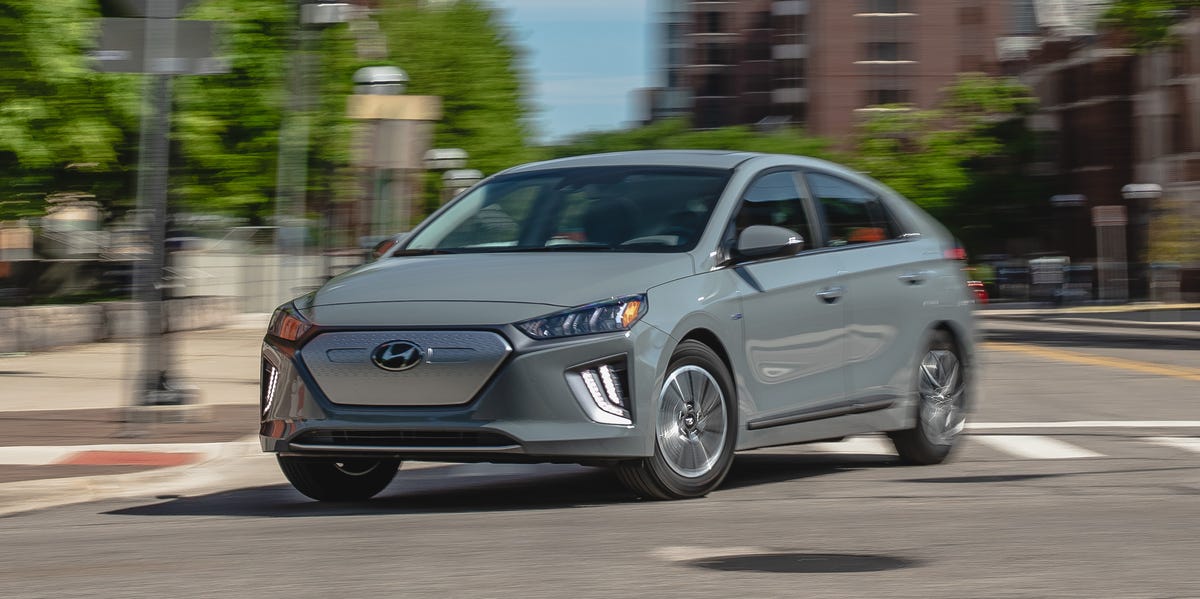
Hyundai’s 2020 Ioniq Electric isn’t all about the range. If you want an EV that will go more than 200 miles on a charge, a Hyundai salesman will walk you over to the $ 38,330 Kona Electric SUV with a 258-mile EPA range. And the Kona isn’t the only alternative. There are plenty of other choices for just a few thousand more than the Ionic EV’s $ 34,020 base price. A Chevrolet Bolt and its 259-mile range starts at $ 37,495, the Nissan Leaf Plus offers 215 miles of range for $ 39,125, and the 250-mile range Tesla Model 3 Standard Range Plus opens for $ 39,190.
But, let’s say you don’t want to spend the extra dough and that the refreshed Ioniq’s 170-mile EPA range works for you. That range is an improvement over the first Ionic Electric, which traveled 124 miles on a charge, and it beats the smaller-battery $ 32,525 Nissan Leaf’s 149-mile range. Credit the new and larger battery (28.0 kWh to 38.3 kWh) for the added range. Charging can also happen faster thanks to a slightly upgraded onboard charger that goes from 6.6 kW to 7.2 kW to help speed charging times for the Ioniq’s larger battery.
Enough with the EPA talk; we have our own range test, one where we drive at a steady 75 mph on the highway. We didn’t subject the previous Ioniq to the same methodology, so there is no direct comparison for the 150 miles of highway range we observed in the updated Ioniq. That makes its freeway legs longer only than the 2017 BMW i3 and both the Bolt and Leaf can cover 180 miles, so don’t expect to road trip. But it is worth noting that the 12 percent drop from it’s EPA range is among the least we have seen, meaning Hyundai is very honest in its own test practices and reporting.
Trucklike Braking and Flappy Paddle Fun
The 2020 Ioniq Electric also comes with a more powerful permanent-magnet synchronous AC motor than last year. While it zaps the same 218 pound-feet of torque to the front wheels, the motor now generates 134 horsepower (up from 118). The additional electrified ponies don’t change the acceleration times much compared with the last Ioniq we tested back in 2017. A run to 60 mph takes a tepid 8.3 seconds, while a Bolt EV does it in 6.7 ticks, and the smaller-battery Leaf does it in 7.4 seconds. The Hyundai still feels punchy around town, especially for anyone who isn’t familiar with the sensation of an electric motor’s instant torque. However, the Ioniq feels particularly languid at highway speeds. It needed 4.9 seconds to make it from 50 and 70 mph, again trailing both the Chevy and Nissan’s EVs.
As reluctant as the Ioniq was to speed up, it was even less willing to slow down in a hurry. We measured a long stopping distance of 191 feet from 70 mph. That’s longer than a 5602-pound GMC Sierra 1500. The Hyundai’s braking performance isn’t an outlier, though. The Bolt EV and Leaf recorded equally long 70-mph-to-zero stops. Blame the low-rolling resistance tires, selected for their ability to stretch every electron, not for grip. Despite the slipperiness of our Ioniq’s narrow 205-section-width rubber, which registered an SUV-like 0.79 g of grip on our 300-foot skidpad, we like how Hyundai gives the driver control over regenerative braking. Controlled via paddles on the steering wheel, it’s possible to select between three different levels of deceleration, or you can hold the left paddle to activate the full potential of regenerative braking. It’s strong enough to bring the car to a complete stop. Never having to touch the brake pedal and maximizing regenerative braking is a fun distraction from the electrified Ioniq’s otherwise commuter-car driving behavior.
Classier Inside and Cheaper Than Rivals
A larger battery and longer range aren’t all that’s new. The 2020 Ioniq Electric also receives a lovelier interior. The redesigned instrument panel benefits from richer materials and a more stylish aesthetic that’s set off at night by the blue glow of ambient lighting. The cabin is also modernized with a new high-res digital gauge cluster and touch-sensitive climate controls, and on our high-spec Limited model, you also get a larger 10.3-inch touchscreen that’s standard on Limited models. Too bad many of the updates are prettier than practical. Hyundai replaced most of the physical buttons with touch controls that don’t offer the same feedback or reliable responses as a button.
Our gray Ioniq Electric Limited arrived with an as-tested price of $ 39,590, but if you forgo some features like blind-spot monitoring and power front seats, you can get into the SE-trim Ioniq for just $ 34,020. We’d recommend the SE, since the Limited doesn’t add any range, and if you’re willing to spend nearly $ 40,000 on an EV, you should get one of the aforementioned ones with longer legs.
This content is created and maintained by a third party, and imported onto this page to help users provide their email addresses. You may be able to find more information about this and similar content at piano.io

